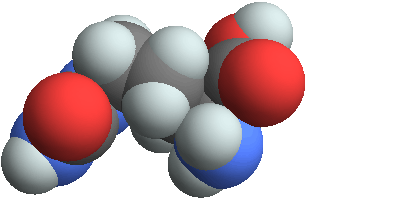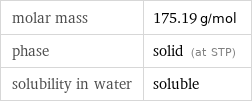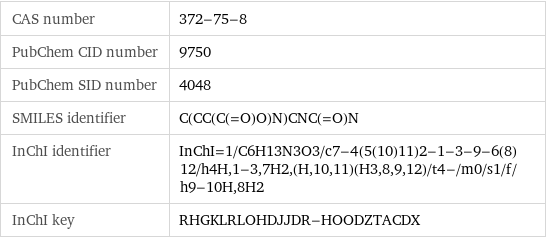Input interpretation

L-citrulline
Chemical names and formulas

formula | C_6H_13N_3O_3 name | L-citrulline IUPAC name | (2S)-2-amino-5-(carbamoylamino)pentanoic acid mass fractions | C (carbon) 41.1% | H (hydrogen) 7.48% | N (nitrogen) 24% | O (oxygen) 27.4%
Lewis structure

Draw the Lewis structure of L-citrulline. Start by drawing the overall structure of the molecule, ignoring potential double and triple bonds: Count the total valence electrons of the carbon (n_C, val = 4), hydrogen (n_H, val = 1), nitrogen (n_N, val = 5), and oxygen (n_O, val = 6) atoms: 6 n_C, val + 13 n_H, val + 3 n_N, val + 3 n_O, val = 70 Calculate the number of electrons needed to completely fill the valence shells for carbon (n_C, full = 8), hydrogen (n_H, full = 2), nitrogen (n_N, full = 8), and oxygen (n_O, full = 8): 6 n_C, full + 13 n_H, full + 3 n_N, full + 3 n_O, full = 122 Subtracting these two numbers shows that 122 - 70 = 52 bonding electrons are needed. Each bond has two electrons, so in addition to the 24 bonds already present in the diagram add 2 bonds. To minimize formal charge oxygen wants 2 bonds and carbon wants 4 bonds. Identify the atoms that want additional bonds and the number of electrons remaining on each atom: Fill in the 2 bonds by pairing electrons between adjacent highlighted atoms: Answer: | |
3D structure

3D structure
Basic properties

molar mass | 175.19 g/mol phase | solid (at STP) solubility in water | soluble
Units

Hydrophobicity and permeability properties

experimental LogP hydrophobicity | -3.9 predicted LogP hydrophobicity | -3.26 predicted LogS | -0.9
Basic drug properties

approval status | approved | nutraceutical | small molecule drug categories | dietary supplement | micronutrient | non-essential amino acid
Chemical identifiers

CAS number | 372-75-8 PubChem CID number | 9750 PubChem SID number | 4048 SMILES identifier | C(CC(C(=O)O)N)CNC(=O)N InChI identifier | InChI=1/C6H13N3O3/c7-4(5(10)11)2-1-3-9-6(8)12/h4H, 1-3, 7H2, (H, 10, 11)(H3, 8, 9, 12)/t4-/m0/s1/f/h9-10H, 8H2 InChI key | RHGKLRLOHDJJDR-HOODZTACDX